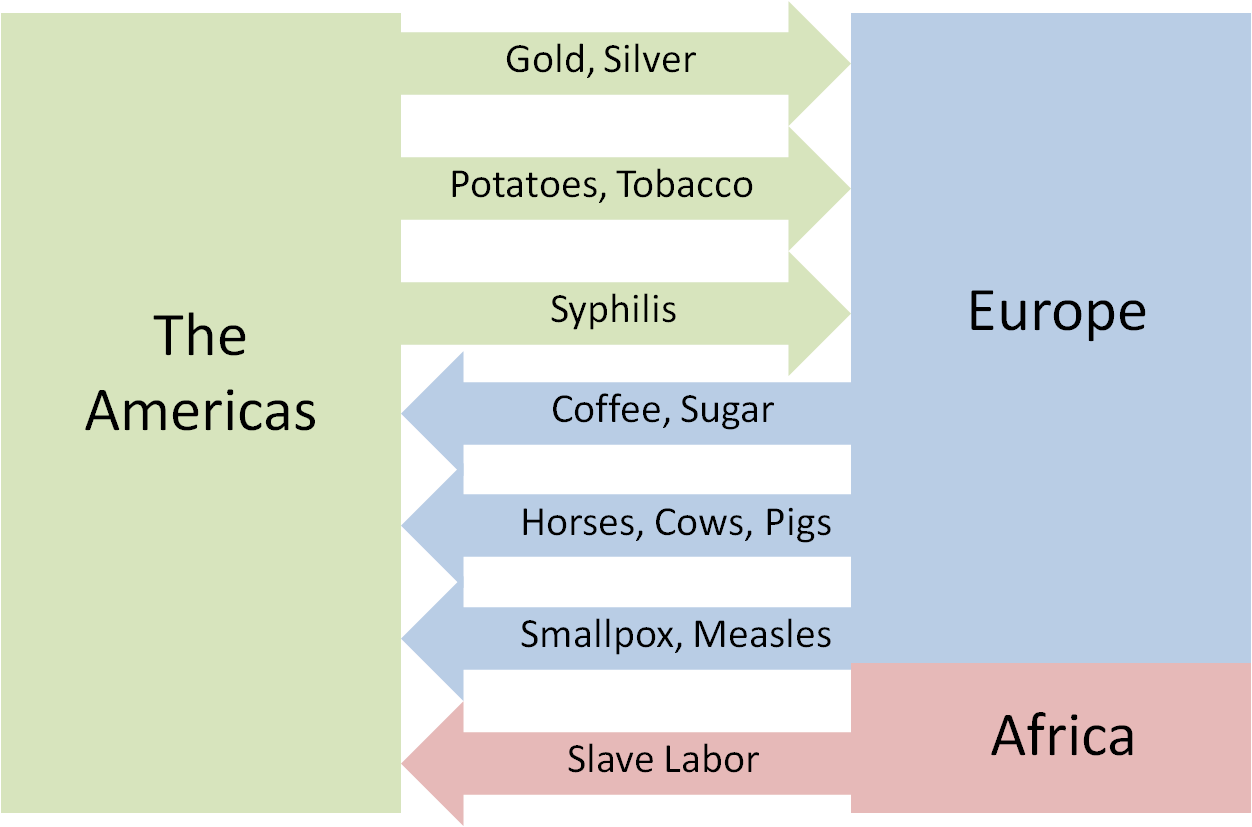All AP US History Resources
Example Questions
Example Question #1 : Ap Us History

Which of the following statements is best supported by the information provided in the diagram above?
In search of power and profit for themselves and their nation, conquering explorers laid waste to large parts of Central and South America, disrupting long-standing civilizations
Improved economic and political stability in Europe paved the way for rapid exploration and settlement of the New World
Violent conflicts occurred between European explorers and the Native Americans, whom the Europeans perceived as racially and culturally inferior
The importation of slaves from Africa to the Americas supplied forced labor to conquering Europeans in the wake of decimation of native populations as a result of disease
One of the goals of European colonization of the Americas and subjugation of Native Populations was religious conversion
The importation of slaves from Africa to the Americas supplied forced labor to conquering Europeans in the wake of decimation of native populations as a result of disease
Note: the diagram was created by the question writer.
While all of the statements are true, the diagram depicts the Columbian exchange, which led to the formation of the Triangular Trade network. The decimation of native populations due to introduced diseases and race-based violence from the colonizing forces led to a labor shortage, leading European explorers to import slaves from Africa. Note that the question asks which statement is best supported by the provided source, so just because an option is true does not make it the correct answer.
Example Question #2 : Ap Us History

Which of the following events was most directly caused by the exchange network depicted in the diagram?
The rise of capitalism among European nations
The Reformation in Europe
The spread of Christianity across the Americas
The intermarriage of Spanish conquerors and native women
The development of the encomienda system
The rise of capitalism among European nations
Note: the diagram was created by the question writer.
Mineral wealth in the form of gold and silver facilitated the European shift from feudalism to capitalism. While the other events did occur in the selected time period (late 15th century - 16th century), the shift towards capitalism can be the most directly tied to the Columbian exchange.
Example Question #1 : Ap Us History
In 1493: Uncovering the New World Columbus Created (published in 2011), the historian Charles H. Mann describes the effects of the Columbian exchange: the unwitting transfer of plants, animals, and microbes between the New World and the Old which transformed life on both sides of the Atlantic Ocean.
According to Mann, among the living things exchanged were tomatoes, potatoes, sugarcane, horses, corn, smallpox, measles, cacao, vanilla, tobacco, rice, onions, and bananas.
Which of the following was a direct, long-term effect of the European arrival in the Americas?
Large numbers of the native population died from diseases for which they had no immunity.
Sugarcane became a cash crop in Caribbean plantations.
All of the answers are correct.
The arrival of horses changed the hunting habits of many North American tribes.
All of the answers are correct.
All of the answers are correct. Although the disease toll of the Columbian exchange is well known, the ecological effects of Europe's arrival in the Americas were no less impactful.
Example Question #2 : Ap Us History
In 1493: Uncovering the New World Columbus Created (published in 2011), the historian Charles H. Mann describes the effects of the Columbian exchange: the unwitting transfer of plants, animals, and microbes between the New World and the Old which transformed life on both sides of the Atlantic Ocean.
According to Mann, among the living things exchanged were tomatoes, potatoes, sugarcane, horses, corn, smallpox, measles, cacao, vanilla, tobacco, rice, onions, and bananas.
Which of the following statements best describes the goals of Europeans traveling to the New World in the 1400s and 1500s?
expanding knowledge by discovering new territories
finding new sources of wealth and spreading Christianity
escaping religious persecution
establishing new settlements for European prisoners
finding new sources of wealth and spreading Christianity
Although eventually colonies in the New World would be settled for all these reasons, the initial motives of Columbus and other early explorers were evangelism and the pursuit of riches.
All AP US History Resources




